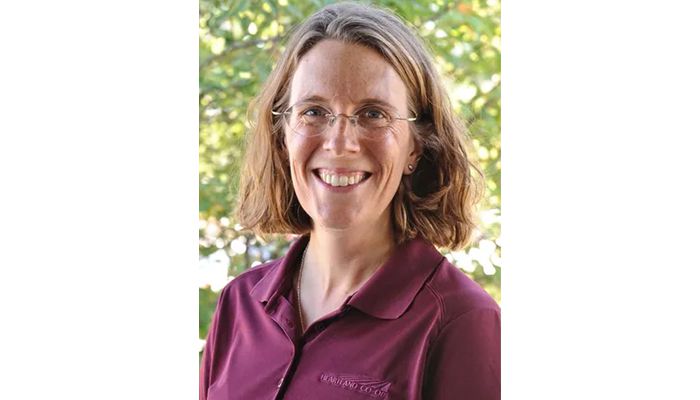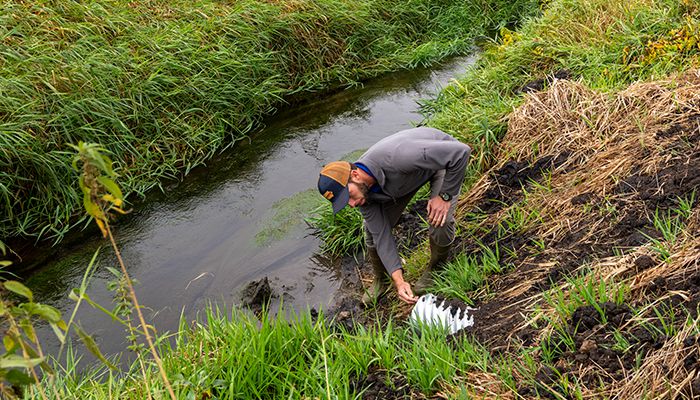Iowa farmers embracing water quality initiatives
Author
Published
11/10/2025
Batch and build projects unite farmers, agencies and industry partners to reduce nutrient runoff and improve Iowa waterways.
Iowa farmers are taking the lead to improve water quality by implementing edge-of-field conservation practices through an innovative “batch and build” model that combines multiple farms, reduces nutrient runoff and accelerates progress toward cleaner waterways.
The latest example of these farmer-led initiatives can be found in the Middle Cedar Watershed near Reinbeck in Grundy and Tama counties, where 14 saturated buffers and four bioreactors have been installed — now actively working to improve water quality and reduce nutrient loss into Iowa’s waterways.
Ruth McCabe, conservation manager with Heartland Co-op, the agricultural service provider overseeing the recently completed batch and build effort, said the project is yet another successful illustration of how Iowa’s farmers are dedicated to improving the state’s waterways. She said bringing multiple agencies together with farmers to engineer and construct conservation practices has proven both economical and effective.
“Eleven landowners are part of the current batch,” McCabe said. “It has been hugely successful. This is extremely rewarding, …going out to find industry partners … to work alongside us and then landowners coming out of the woodwork wanting to do this work.”
“It’s been so amazing to me personally to know that we’re improving farmland, … improving the productivity of Iowa’s farmscape. We’re improving ecosystem services that are being returned to the environment. We are making landowners happy. We’re sending cleaner water downstream. It’s a movement that’s been growing over the last six years … and I’m just watching it mushroom across the state.”

PICTURED ABOVE: McCabe
Middle Clear Project
Edge-of-field practices in the Middle Cedar Watershed are nearing completion, now reducing nutrient loss into waterways in Grundy and Tama counties and further south toward Cedar Rapids.
Batch and builds reflect a dedication to following the Iowa Nutrient Reduction Strategy (INRS), a science-based approach to reduce nutrients delivered to Iowa’s waterways and the Gulf of America. The INRS outlines voluntary efforts to reduce nutrient runoff from farm fields and urban areas, as well as wastewater from treatment plants.
Saturated buffers and bioreactors are critical to the success of the INRS, gaining popularity as efficient tools to reduce nutrient loss, said Emery Davis, conservation agronomist with Heartland Co-op, who oversees batch and build projects in central and eastern Iowa.
He said the Middle Cedar project alone is estimated to reduce nitrate loss leaving the tile outlet through water infiltration in saturated buffer areas and through bioreactors by approximately 50%.
The Middle Cedar buffers are servicing 2,658 acres across the region, treating 24 tile outlets in the watershed.
Surveying and engineering for the batch and build began in March 2024, with construction beginning in summer 2025. Completion is expected this month.
Saturated buffers divert water from the field through a water control box, filtering the water underground before it reaches a nearby waterway.
“Once we get saturated buffers installed, they should operate for a couple dozen years,” Davis explained. “They’re out of the way and don’t affect any of the row crop operations. Every day and night they’re cleaning the water … and that’s important for drinking water and water quality downstream.
“The City of Cedar Rapids pulls its drinking water out of this area of the Cedar River, so this is helping them with their drinking water so they don’t have to treat as many nitrates.”

PICTURED ABOVE: Heartland Co-op’s Emery Davis checks a drainage tile outlet at one of the batch and build projects in the Middle Cedar Watershed. PHOTO / CONRAD SCHMIDT
Landowner buy-in
Ben Gleason, executive director of the Iowa Nutrient Research and Education Council (INREC) in Ankeny and secretary/treasurer of the Iowa Seed Association (ISA), said the batch and build model is key to implementing successful water quality initiatives. Both organizations have provided funding for batch and build projects as part of their overall conservation strategy.
The ISA partnered with Heartland Cooperative, the Cedar River Source Water Partnership, Agriculture’s Clean Water Alliance, BASF, Syngenta, Unilever and the Iowa Department of Agriculture and Land Stewardship (IDALS) to make the Middle Cedar Watershed project possible.
“What ISA does is we help recruit landowners … and help coordinate with Heartland to find private funding,” Gleason said. “It’s been working well with lots of interest from the private sector. Batch and builds are great projects, and we’re excited to partner (in the efforts).”
IDALS provided technical, design and engineering support as well as cost share for practice installation. The Iowa Seed Association also served as fiscal agent, while ISG Inc. provided design services and Laser Precision handled construction. ISA also helped with the payments that need to be made for crop damage, temporary construction easement payments and other costs that IDALS can’t cover.
The Heartland Co-op-led batch and build model required no out-of-pocket expenses from landowners and provides a privately funded additional incentive payment per tile outlet treated.
Landowner buy-in was an essential part of the process, and McCabe said there has been significant interest from farmers in her region to implement practices that reduce nutrient loss.
“When we hold field days and meetings … , you should see the room,” McCabe said. “There are hundreds of people that come to these, and they’re all very excited.”
McCabe said peer-to-peer conversations drive participation.
Corn and soybean growers Jon Robertson and Ross Devick, who farm near Reinbeck, signed on for the Middle Cedar Watershed project and had saturated buffers installed along their fields. They said the experience was rewarding, as Heartland Co-op staff handled the engineering, surveying and government paperwork while coordinating installation with contractors.
“The conservation aspect of this makes complete sense,” said Robertson. “You have to be in a conservation mindset … We’re not making any more (soil), so let’s protect what we have. Buffer strips are so important. I wish everybody would try it. Would go a long way toward mitigating the effect of the nitrogen getting into the waterways.”
Devick agreed, adding that conservation measures also limit erosion while combating nitrogen loss. “That’s always been our enemy,” he said. “Nobody farms the same, and we’re all trying different conservation practices … trying to do the right thing.
“If there’s any way we could remind people (about the importance of preserving the soil and water), we need to do that.”
Future projects
Iowa Secretary of Agriculture Mike Naig said projects such as these are making a measurable difference across the state.
Farmers, he said, are leading the way by implementing conservation measures that protect the soil and improve water quality.
“The batch and build model has been a great approach to generate interest among farmers and landowners and scale-up adoption of conservation practices in priority watersheds around Iowa,” said Naig. “Thank you to our partners who helped make this happen and to the farmers who said yes to adding these nitrate reducing practices.
“This effort in the Middle Cedar Watershed is another great example of how public and private partners, farmers and landowners are working together to build conservation capacity and more efficiently deliver measurable results.”
Heartland Co-op is planning additional projects. Beyond the Middle Cedar Watershed effort, the co-op recently oversaw construction of 15 bioreactors and 26 saturated buffers treating 48 tile outlets in the Lower Cedar Watershed.
It also has a batch and build project planned for 2026 in Marshall and Poweshiek counties and a second project in the Lower Cedar Watershed.
“We are still going to be working on saturated buffers and bioreactors … and we’re moving now in the direction of doing oxbow wetland restorations,” McCabe explained.
Additionally, Heartland has developed a small conservation endowment fund to provide a continual, reliable source of small-scale funding for local or regional projects.
“The point of our fund is to fill gaps if we ever run into a funding problem,” she said. “Right now all of our funding is very secure but can dry up pretty fast.”
McCabe encourages interested farmers to visit with their peers and tour a farm where projects have been implemented to see firsthand how edge-of-field practices work.
“I go to bed just about every night feeling really good about the work that we do,” McCabe said. “Every time we have a meeting, a watershed management authority board meeting or a field day, the energy in the room is always palpable. People are excited, and that feels really good.”
Want more news on this topic? Farm Bureau members may subscribe for a free email news service, featuring the farm and rural topics that interest them most!